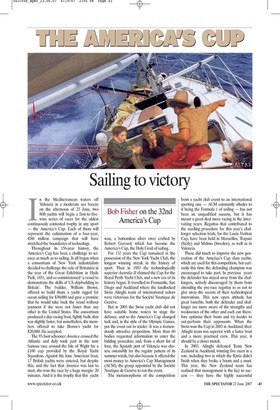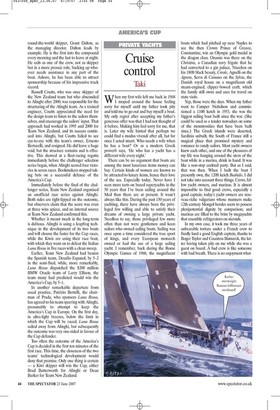Sailing to victory
Bob Fisher on the 32nd America's Cup n the Mediterranean waters off Valencia in a moderate sea breeze on the afternoon of 23 June, two 80ft yachts will begin a first-to-fivewins series of races for the oldest continuously contested trophy in any sport — the America's Cup. Each of them will represent the culmination of a four-year, €80 million campaign that will have stretched the boundaries of technology.
Throughout its 156-year history, the America's Cup has been a challenge to science as much as to sailing. It all began when a consortium of New York industrialists decided to challenge the rule of Britannia in the year of the Great Exhibition in Hyde Park, 1851, and so commissioned 'a vessel to demonstrate the skills of US shipbuilding to Britain'. The builder, William Brown, offered to build them a yacht rigged for ocean sailing for $30,000 and gave a promise that he would take back the vessel without payment if she were not faster than any other in the United States. The consortium produced a day-racing boat, lightly built, that was slightly faster, but nonetheless, the members offered to take Brown's yacht for $20,000. He accepted.
The 93-foot schooner America crossed the Atlantic and duly took part in the now famous race around the Isle of Wight for a £100 cup provided by the Royal Yacht Squadron. Against the lone American boat, 17 British yachts were entered, but despite this, and the fact that America was last to start, she won the race by a huge margin: 20 minutes. And it is the trophy that this yacht won, a bottomless silver ewer crafted by Robert Garrard, which has become the America's Cup, the Holy Grail of sailing.
For 132 years the Cup remained in the possession of the New York Yacht Club, the longest winning streak in the history of sport. Then in 1983 the technologically superior Australia II claimed the Cup for the Royal Perth Yacht Club, and a new era of its history began. It travelled to Fremantle, San Diego and Auckland where the landlocked Swiss Alinghi team of international sailors were victorious for the Societe Nautique de Geneve.
But in 2003 the Swiss yacht club did not have suitable home waters to stage the defence, and so the America's Cup changed tack and, in the style of the Olympic Games, put the event out to tender. It was a tremendously attractive proposition. More than 60 bodies requested information to enter the bidding procedure and, from a short list of four, the Spanish port of Valencia was chosen, ostensibly for the regular pattern of its summer winds, but also because it offered the most money to America's Cup Management (ACM), the group appointed by the Societe Nautique de Geneve to run the event.
The metamorphosis of the competition from a yacht club event to an international sporting one — ACM constantly alludes to it being the Formula 1 of sailing — has not been an unqualified success, but it has meant a great deal more racing in the intervening years. Regattas that contributed to the seeding procedure for this year's challenger selection trials, for the Louis Vuitton Cup, have been held in Marseilles, Trapani (Sicily) and Malmo (Sweden), as well as in Valencia.
These did much to improve the new generation of the America's Cup class yachts, which are used for this competition, but curiously this time the defending champion was encouraged to take part. In previous years the defender has stayed away from the challengers, actively discouraged by them from attending the pre-race regattas so as not to give away the secrets of their technological innovations. This new open attitude has great benefits; both the defender and challenger are more aware of the strengths and weaknesses of the other and each can therefore optimise their boats and try harder to out-perform their opponents. When the Swiss won the Cup in 2003 in Auckland, their Alinghi team was superior with a faster boat and a more practised crew. This year, it should be a closer match.
In 2003, Alinghi defeated Team New Zealand in Auckland, winning five races in a row, including two in which the Kiwis didn't finish when they broke a boom and a mast. This year, the New Zealand team has realised that management is the key to success — they have the highly successful round-the-world skipper, Grant Dalton, as the managing director. Dalton leads by example. He is the first into the compound every morning and the last to leave at night. He sails as one of the crew, not as skipper but in a more prosaic role, backing up whoever needs assistance in any part of the boat. Ashore, he has been able to attract sponsorship because of his impressive track record.
Russell Coutts, who was once skipper of the New Zealand team but who absconded to Alinghi after 2000, was responsible for the structuring of the Alinghi team. As a trained engineer, Coutts appreciated the need for the design team to listen to the sailors themselves, and encourage the sailors' input. That approach had worked in 1995 and 2000 for Team New Zealand, and its success continued into Alinghi, but Coutts failed to see eye-to-eye with the team's owner, Ernesto Bertarelli, and resigned. He did leave a huge void, but the structure remains and is effective. This showed at a fleet-racing regatta immediately before the challenger selection series began, when Alinghi scored four victories in seven races. Bookmakers stopped taking bets on a successful defence of the America's Cup.
Immediately before the final of the challenger series, Team New Zealand organised an unofficial race series against Alinghi Both sides are tight-lipped on the outcome, but observers claim that the score was even at three wins apiece, and an internal source at Team New Zealand confirmed this.
Whether it meant much in the long-term is dubious. Alinghi is using a leapfrog technique in the development of its two boats and will choose the faster for the Cup races, while the Kiwis are using their race boat, with which they went on to defeat the Italian Luna Rossa in five races with a clean sweep.
Earlier, Team New Zealand had beaten the Spanish team, Desafio Espanol, by 5-2 in the semi-final, while, more remarkably, Luna Rossa dispatched the $200 million BMW Oracle team of Larry Ellison, the team many had predicted would win the America's Cup, by 5-1.
In another remarkable departure from usual practice, Patrizio Bertelli, the chairman of Prada, who sponsors Luna Rossa, has agreed to his team sparring with Alinghi, presumably to attempt to keep the America's Cup in Europe. On the first day, in ultra-light breezes, below the limit in which the Cup will be raced, Luna Rossa sailed away from Alinghi, but subsequently the outcome was very one-sided in favour of the Cup defender.
Too often the outcome of the America's Cup is decided in the first ten minutes of the first race. This time, the closeness of the two teams' technological development would deny that premise. Only one thing is certain — a Kiwi skipper will win the Cup, either Brad Butterworth for Alinghi or Dean Barker for Team New Zealand.






























































 Previous page
Previous page